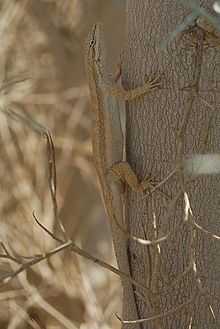Urosaurus graciosus
| Urosaurus graciosus | |
|---|---|
 | |
| Scientific classification | |
| Kingdom: | Animalia |
| Phylum: | Chordata |
| Class: | Sauropsida |
| Order: | Squamata |
| Suborder: | Lacertilia |
| Family: | Phrynosomatidae |
| Genus: | Urosaurus |
| Species: | U. graciosus |
| Binomial name | |
| Urosaurus graciosus (Hallowell, 1854) | |
The long-tailed brush lizard, Urosaurus graciosus, occurs in the Mojave and northwestern Sonoran Deserts in the states of California, Arizona, Nevada, Sonora, and Baja California. This species received its common name due to its tail, which is more than twice the body length, and since it is almost always encountered on a tree or shrub. Its gray or tan coloration keep it well camouflaged against branches while it waits for insects. Unlike most other phrynosomatid lizards, which bury in the sand at night during warm weather, U. graciosus spends the night on the tips of branches.
U. graciosus is distinguishable from its close relative the tree lizard, Urosaurus ornatus, by the presence of a tail more than two times its snout-vent length and the absence of a series of smaller scales running down the middle of the band of enlarged dorsal scales. U. graciosus is distinguishable from the black-tailed brush lizard, Urosaurus nigricaudus, by the presence of a tail more than two times its snout-vent length and relatively large dorsal scales transitioning abruptly into granular lateral scales (in U. nigricaudus, the dorsal scales are only slightly enlarged and transition gradually into the granular lateral scales). It is distinguishable from all other brush lizards (Urosaurus) by geography.
External links
- californiaherps.com Urosaurus graciosus page
- calphotos.berkeley.edu Urosaurus graciosus page
- wildherps.com Urosaurus graciosus page
- Arizona PARC Urosaurus graciosus page
- Cabeza Prieta Natural History Association Urosaurus graciosus page
References
- Reeder, Tod W. and John J. Wiens 1996. Evolution of the Lizard Family Phrynosomatidae as Inferred from Diverse Types of Data. Herpetological Monographs 10: 43-84.
- Stebbins, Robert C. 2003. Western Reptiles and Amphibians (3rd ed.). Boston: Houghton Mifflin Co. ISBN 0-395-98272-3.
- Wiens, John J. 1993. Phylogenetic Systematics of the Tree Lizards (Genus Urosaurus). Herpetologica 49(4): 399-420.